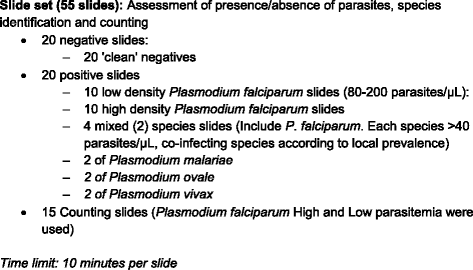Immediate assessment of performance of medical laboratory scientists following a 10-day malaria microscopy training programme in Nigeria
- PMID: 29202100
- PMCID: PMC5683359
- DOI: 10.1186/s41256-017-0051-x
Immediate assessment of performance of medical laboratory scientists following a 10-day malaria microscopy training programme in Nigeria
Abstract
Background: Rapid and precise diagnosis of malaria is an essential element in effective case management and control of malaria. Malaria microscopy is used as the gold standard for malaria diagnosis, however results remain poor as positivity rate in Nigeria is consistently over 90%. The United States President's Malaria Initiative (PMI) through the Malaria Action Program for States (MAPS) supported selected states in Nigeria to build capacity for malaria microscopy. This study demonstrates the effectiveness of in-service training on malaria microscopy amongst medical laboratory scientists.
Method: The training was based on the World Health Organization (WHO) basic microscopy training manual. The 10-day training utilized a series of didactic lectures and examination of teaching slides using a CX 21 Olympus binocular microscope. All 108 medical laboratory scientists trained from 2012 to 2015 across five states in Nigeria supported by PMI were included in the study. Evaluation of the training using a pre-and post-test method was based on written test questions; reading photographic slide images of malaria parasites; and prepared slides.
Result: There was a significant improvement in the mean written pre-and post-tests scores from 37.9% (95% CI 36.2-39.6%) to 70.7% (95% CI 68.4-73.1%) (p < 0.001). The mean counting post-test score improved significantly from 4.2% (95% CI 2.6-5.7%) to 27.9% (95% CI 25.3-30.5%) (p < 0.001). Mean post-test score for computer-based picture speciation test (63.0%) and picture detection test (89.2%) were significantly higher than the mean post-test score for slide reading speciation test (38.3%) and slide reading detection test (70.7%), p < 0.001 in both cases.
Conclusion: Parasite detection and speciation using enhanced visual imaging was significantly improved compared with using direct microscopy. Regular in-service training and provision of functional and high resolution microscopes are needed to ensure quality routine malaria microscopy.
Keywords: Malaria; Microscopy; Nigeria; Training.
Conflict of interest statement
Authors’ information
BA is a public health physician and was the Implementation Director for the malaria project, AO is a laboratory scientist and was the Malaria Diagnosis Specialist, AA is a medical doctor and was the M&E Specialist, JU was the M&E Advisor, OA was the Chief of Party while HM was the Technical Director based in Washington DC.
Ethics approval and consent to participate
Not applicable.
Consent for publication
Not applicable.
Competing interests
The authors declare that they have no competing interests.
Figures
Similar articles
-
Impact of malaria diagnostic refresher training programme on competencies and skills in malaria diagnosis among medical laboratory professionals: evidence from Ghana 2015-2019.Malar J. 2021 Jun 8;20(1):255. doi: 10.1186/s12936-021-03796-x. Malar J. 2021. PMID: 34103068 Free PMC article.
-
Assessment of competence of participants before and after 7-day intensive malaria microscopy training courses in Nigeria.Malariaworld J. 2015 Jun 9;6:6. doi: 10.5281/zenodo.10870129. eCollection 2015. Malariaworld J. 2015. PMID: 38779622 Free PMC article.
-
Establishing a malaria diagnostics centre of excellence in Kisumu, Kenya.Malar J. 2007 Jun 12;6:79. doi: 10.1186/1475-2875-6-79. Malar J. 2007. PMID: 17565676 Free PMC article.
-
Decline in malaria test positivity rates following capacity building and archiving of malaria rapid diagnostic test cassettes in Oyo State, Nigeria: a retrospective review of records.Malar J. 2025 Apr 22;24(1):132. doi: 10.1186/s12936-025-05352-3. Malar J. 2025. PMID: 40264146 Free PMC article.
-
Evaluation of a laboratory quality assurance pilot programme for malaria diagnostics in low-transmission areas of Kenya, 2013.Malar J. 2017 May 25;16(1):221. doi: 10.1186/s12936-017-1856-2. Malar J. 2017. PMID: 28545579 Free PMC article.
Cited by
-
Health care provider practices in diagnosis and treatment of malaria in rural communities in Kisumu County, Kenya.Malar J. 2022 Apr 22;21(1):129. doi: 10.1186/s12936-022-04156-z. Malar J. 2022. PMID: 35459178 Free PMC article.
-
Impact of malaria diagnostic refresher training programme on competencies and skills in malaria diagnosis among medical laboratory professionals: evidence from Ghana 2015-2019.Malar J. 2021 Jun 8;20(1):255. doi: 10.1186/s12936-021-03796-x. Malar J. 2021. PMID: 34103068 Free PMC article.
-
High value of rapid diagnostic tests to diagnose malaria within children: A systematic review and meta-analysis.J Glob Health. 2020 Jun;10(1):010411. doi: 10.7189/jogh.10.010411. J Glob Health. 2020. PMID: 32373330 Free PMC article.
-
Pan African Vivax and Ovale Network (PAVON) Malaria Diagnostic Competency Training: Offering Training Opportunities to Impact Malaria Elimination Strategies in Sub-Saharan Africa.Trop Med Infect Dis. 2024 Dec 19;9(12):308. doi: 10.3390/tropicalmed9120308. Trop Med Infect Dis. 2024. PMID: 39728835 Free PMC article.
-
Cost-effectiveness analysis of malaria rapid diagnostic tests: a systematic review.Infect Dis Poverty. 2019 Dec 30;8(1):104. doi: 10.1186/s40249-019-0615-8. Infect Dis Poverty. 2019. PMID: 31888731 Free PMC article.
References
-
- WHO. World Malaria Report. s.l. : World Health Organization, 2014.
-
- Onwujekwe O, Mangham-Jefferies L, Cundill B, Alexander N, Langham J, Ibe O, et al. Effectiveness of Provider and Community Interventions to Improve Treatment of Uncomplicated Malaria in Nigeria: A Cluster Randomized Controlled Trial. PLoS ONE. 2015;10(8):e0133832. doi: 10.1371/journal.pone.0133832. - DOI - PMC - PubMed
-
- FMoH. National Guidelines for Diagnosis and Treatment of Malaria. Abuja : Federal Ministry of Health: National Malaria and Vector Control Division, 2011.
LinkOut - more resources
Full Text Sources
Other Literature Sources


